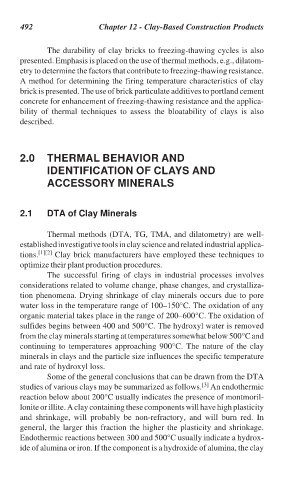Page 521 - Handbook of Thermal Analysis of Construction Materials
P. 521
492 Chapter 12 - Clay-Based Construction Products
The durability of clay bricks to freezing-thawing cycles is also
presented. Emphasis is placed on the use of thermal methods, e.g., dilatom-
etry to determine the factors that contribute to freezing-thawing resistance.
A method for determining the firing temperature characteristics of clay
brick is presented. The use of brick particulate additives to portland cement
concrete for enhancement of freezing-thawing resistance and the applica-
bility of thermal techniques to assess the bloatability of clays is also
described.
2.0 THERMAL BEHAVIOR AND
IDENTIFICATION OF CLAYS AND
ACCESSORY MINERALS
2.1 DTA of Clay Minerals
Thermal methods (DTA, TG, TMA, and dilatometry) are well-
established investigative tools in clay science and related industrial applica-
tions. [1][2] Clay brick manufacturers have employed these techniques to
optimize their plant production procedures.
The successful firing of clays in industrial processes involves
considerations related to volume change, phase changes, and crystalliza-
tion phenomena. Drying shrinkage of clay minerals occurs due to pore
water loss in the temperature range of 100–150°C. The oxidation of any
organic material takes place in the range of 200–600°C. The oxidation of
sulfides begins between 400 and 500°C. The hydroxyl water is removed
from the clay minerals starting at temperatures somewhat below 500°C and
continuing to temperatures approaching 900°C. The nature of the clay
minerals in clays and the particle size influences the specific temperature
and rate of hydroxyl loss.
Some of the general conclusions that can be drawn from the DTA
[3]
studies of various clays may be summarized as follows. An endothermic
reaction below about 200°C usually indicates the presence of montmoril-
lonite or illite. A clay containing these components will have high plasticity
and shrinkage, will probably be non-refractory, and will burn red. In
general, the larger this fraction the higher the plasticity and shrinkage.
Endothermic reactions between 300 and 500°C usually indicate a hydrox-
ide of alumina or iron. If the component is a hydroxide of alumina, the clay

